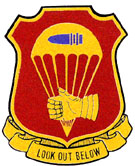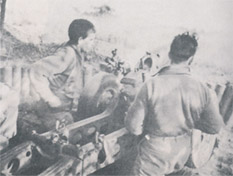|
|
.
376th . PARACHUTE Field ARTILLERY BATTALION |
|
On March 25, 1942, the 376th Field Artillery Battalion was reactivated and reorganized at Camp Claiborne, Louisiana.
On August 16, 1942, the 376th was re-designated Parachute Field Artillery Battalion (PFAB) and attached to the 82nd Airborne Division.
During the next 11 months, It trained under the command of Lieutenant Colonel Wilbur Maben Griffith who took command of the 376th in November 1942.
In September 44, Griffith became Division Artillery Executive Officer of the 82nd. The Executive Officer of the 456th PFAB, Major Robert H. Neptune was promoted to Lieutenant Colonel and took command of the 376th PFAB until the end of the war.
.jpg) <- Major Robert H. Neptune (Here in Colonel's uniforme)
<- Major Robert H. Neptune (Here in Colonel's uniforme)
On May 10, 1943, the 376th arrives in Casablanca in French Morocco to begin to prepare for operations in Sicily. Some days later, after heavy fighting, General Patton decided to reinforce its central device. To do this, he decided to drop more than 2,000 men he held in reserve. They are the 1st and 2nd Battalion, 504th PIR, 376th PFAB and C Company of 307th. They had jumped on the runway Farello held by the Americans.
Unfortunately, the waves of C-47 followed an air attack by the Luftwaffe. The gunners of the DCA, nervous, opened fire on the aircraft destroyed 23 C-47, damaging 37 of a total of 144 transport aircraft. Losses are estimated at 10% of the workforce. The investigation revealed that not everyone was unaware of the operation.
After Sicily, the 504th PIR and the 376th PFAB were merged to form the 504th Regimental Combat Team. They fought all the rest of the war.
![]()
To go beyond the "Gustav Line", the German defensive line, an operation was planned at Anzio. The 504th RCT (including the 504th, 376th PFAB, C Company of 307th) fought as a private in the infantry advance on Rome. It was withdrawn from combat January 4, 1944 to prepare for the operation on Anzio. The 504th RCT was assigned to seize the town of Borgo Piave, January 24. Although the mission is a success, they were repulsed by German Panzers. They then held a defensive position along the Mussolini Canal finally found January 28.
In March, the 376th was removed from the front and joined the 82nd in England to prepare for the invasion of France.
![]() Holland - September
1944 - Operation Market Garden
Holland - September
1944 - Operation Market Garden
On September 9, 1944, The British Field Marshal Montgomery proposed a plan called Market Garden was intended to set a bridgehead to the Rhine.
The operation was a combination of an airborne assault to take and hold key bridges and roads of Holland and a feed motor.
The mission of the 504th RCT was to capture two bridges crossing over the Maas-Waal Canal. The operation began September 17. The 504th RCT able to quickly seize the first bridge over the river Maas.
On 20 September, with the support of artillery, the 504th RCT went to attack the other side of the Waal. A D-Day 4, the bridge was assumed they did even in the face against a German attack.
The Regimental motto: "Strike Hold" was demonstrated on the battlefield. The 504th RCT, tired but determined, has achieved their mission and never gave an inch.
However, its success would be short-lived because the defeat of the Allied troops at Arnhem.
The move to Germany would not open in September 1944 and the 82nd was sent to France.
![]() Belgium - December 1944 - Operation Battle of the Bulge
Belgium - December 1944 - Operation Battle of the Bulge
On December 16, 1944, the Germans launched an offensive through the Belgian Ardennes surprising the Allied Forces.
Two days later, the 82nd was sent to Werbomont to block the German advance.
On 19 December morning, the 82nd came in Belgium and was heading north while the 101st was sent to Bastogne.
The German advance separated the two airborne units.
The 82nd has generally faces great difficulty in taking positions along the north edge of the salient.
The 504th RCT gained a second Presidential Unit Citation.
The counteroffensive led the 504th RCT on the banks of the Rhine. On April 6, 1945, the company crossed up to the village Hitsdorf as a tactic to fool the enemy of the true cross.
For this action, the 504th RCT received another Presidential Unit Citation.
The war was officially ended in Europe May 5, 1945.
The 82nd was invited to serve as occupation forces in the American sector of Berlin.
On January 3, 1946, the 82nd was sent to the United States. They marched in the Victory Parade in New York along the 5th Avenue.


